Canopy Transpiration Mapping in an Apple Orchard Using High-Resolution Airborne Spectral and Thermal Imagery with Weather Data
Abstract
1. Introduction
2. Materials and Methods
2.1. Study Site
2.2. Aerial Imaging
2.3. Weather Data
2.4. Evapotranspiration Mapping
2.5. Ground Reference Data
2.6. Data Analysis
3. Results
3.1. High-Resolution Evapotranspiration and Transpiration Mapping
3.2. UASM-1 vs. UASM-2 for ET Mapping
3.3. Weather Specificity and Apple Tree Transpiration Estimation
3.3.1. Weather Variation Around the Orchard
3.3.2. Weather Variation Along Canopy Heights
3.3.3. Effect on Tree Transpiration Estimation
4. Discussion
5. Conclusions
Author Contributions
Funding
Data Availability Statement
Acknowledgments
Conflicts of Interest
References
- Elarab, M. The Application of Unmanned Aerial Vehicle to Precision Agriculture: Chlorophyll, Nitrogen, and Evapotranspiration Estimation. Ph.D. Thesis, Utah State University, Logan, UT, USA, 2016. [Google Scholar]
- Chandel, A.K.; Molaei, B.; Khot, L.R.; Peters, R.T.; Stöckle, C.O. Small UAS-based multispectral and thermal infrared imagery driven energy balance model for high-resolution evapotranspiration estimation of irrigated field crops. Drones 2020, 4, 52. [Google Scholar] [CrossRef]
- Chávez, J.L.; Torres-Rua, A.; Boldt, W.E.; Zhang, H.; Robertson, C.; Marek, G.; Wang, D.; Heeren, D.; Taghvaeian, S.; Neale, C.M. A Decade of Unmanned Aerial Systems in Irrigated Agriculture in the Western US. Appl. Eng. Agric. 2020, 36, 423–436. [Google Scholar] [CrossRef]
- Chandel, A.K.; Khot, L.R.; Molaei, B.; Peters, R.T.; Stöckle, C.O.; Jacoby, P.W. High-Resolution Spatiotemporal Water Use Mapping of Surface and Direct-Root-Zone Drip-Irrigated Grapevines Using Uas-Based Thermal and Multispectral Remote Sensing. Remote Sens. 2021, 13, 954. [Google Scholar] [CrossRef]
- Allen, R.G.; Pereira, L.S.; Raes, D.; Smith, M. FAO Irrigation and Drainage Paper No. 56; Food and Agriculture Organization of the United Nations: Rome, Italy, 1998; Volume 56, p. e156. [Google Scholar]
- Chandel, A.K.; Khot, L.R.; Stöckle, C.O.; Peters, R.T.; Mantle, S. Spatiotemporal water use mapping of a commercial apple orchard using UAS based spectral imagery. In Proceedings of the 2020 IEEE International Workshop on Metrology for Agriculture and Forestry (MetroAgriFor), Virtual Conference, 4–6 November 2020; pp. 268–272. [Google Scholar]
- McShane, R.R.; Driscoll, K.P.; Sando, R. A Review of Surface Energy Balance Models for Estimating Actual Evapotranspiration with Remote Sensing at High Spatiotemporal Resolution over Large Extents. In Scientific Investigations Report 2017; U.S. Department of the Interior, U.S. Geological Survey: Reston, VA, USA, 2017. [Google Scholar]
- Allen, R.G.; Tasumi, M.; Trezza, R. Satellite-based energy balance for mapping evapotranspiration with internalized calibration (METRIC)-Model. J. Irrig. Drain. Eng. 2007, 133, 380–394. [Google Scholar] [CrossRef]
- Allen, R.G.; Tasumi, M.; Morse, A.; Trezza, R.; Wright, J.L.; Bastiaanssen, W.; Kramber, W.; Lorite, I.J.; Robison, C.W. Satellite-based energy balance for mapping evapotranspiration with internalized calibration (METRIC)—Applications. J. Irrig. Drain. Eng. 2007, 133, 395–406. [Google Scholar] [CrossRef]
- Carrasco-Benavides, M.; Ortega-Farías, S.; Lagos, L.O.; Kleissl, J.; Morales, L.; Poblete-Echeverría, C.; Allen, R.G. Crop coefficients and actual evapotranspiration of a drip-irrigated Merlot vineyard using multispectral satellite images. Irrig. Sci. 2012, 30, 485–497. [Google Scholar] [CrossRef]
- Carrasco-Benavides, M.; Ortega-Farías, S.; Lagos, L.; Kleissl, J.; Morales-Salinas, L.; Kilic, A. Parameterization of the satellite-based model (METRIC) for the estimation of instantaneous surface energy balance components over a drip-irrigated vineyard. Remote Sens. 2014, 6, 11342–11371. [Google Scholar] [CrossRef]
- Paço, T.A.; Pôças, I.; Cunha, M.; Silvestre, J.C.; Santos, F.L.; Paredes, P.; Pereira, L.S. Evapotranspiration and crop coefficients for a super intensive olive orchard. An application of SIMDualKc and METRIC models using ground and satellite observations. J. Hydrol. 2014, 519, 2067–2080. [Google Scholar] [CrossRef]
- la Fuente-Sáiz, D.; Ortega-Farías, S.; Fonseca, D.; Ortega-Salazar, S.; Kilic, A.; Allen, R. Calibration of metric model to estimate energy balance over a drip-irrigated apple orchard. Remote Sens. 2017, 9, 670. [Google Scholar] [CrossRef]
- Ortega, S. Evaluation of the METRIC Model for Mapping Energy Balance Components and Actual Evapotranspiration for a Super-Intensive Drip-Irrigated Olive Orchard. Ph.D. Thesis, University of Nebraska-Lincoln, Lincoln, NE, USA, 2019. [Google Scholar]
- Chávez, J.L.; Gowda, P.H.; Howell, T.A.; Garcia, L.A.; Copeland, K.S.; Neale, C.M.U. ET mapping with high-resolution airborne remote sensing data in an advective semiarid environment. J. Irrig. Drain. Eng. 2012, 138, 416–423. [Google Scholar] [CrossRef]
- Liu, B.J.; Sha, D.G.; Shen, X.P. The Analysis of Reference Crop Evapotranspiration Methods. J. Irrig. Drain. Eng. 2006, 25, 9–12. [Google Scholar]
- Han, W.F.; Wu, J.C.; He, F. Summarization on researches on the crop water requirement. J. North China Inst. Water Conserv. Hydroelectr. Power 2008, 29, 32–35. [Google Scholar]
- Yu, Q.; Shah, K.; Wang, D.; Ma, Y.; Wang, Z. Model Based Study of Crop Evapotranspiration under Canopy Shading. Agronomy 2019, 9, 334. [Google Scholar] [CrossRef]
- Allen, R.G.; Walter, I.A.; Elliott, R.L.; Howell, T.A.; Itenfisu, D.; Jensen, M.E.; Snyder, R.L. The ASCE standardised reference evapotranspiration equation. In Task Committee on Standardization of Reference Evapotranspiration of the EWRI of the ASCE; ASCE: Reston, VI, USA, 2005. [Google Scholar]
- Kalma, J.D.; Stanhill, G. Transpiration, evaporation and deep drainage losses from an orange plantation. Israel J. Agric. Res. 1969, 19, 11–24. [Google Scholar]
- Jia, X.; Dukes, M.D.; Jacobs, J.M.; Haley, M. Impact of weather station fetch distance on reference evapotranspiration calculation. In Proceedings of the Restoring Our Natural Habitat. In Proceedings of the 2007 World Environmental and Water Resources Congress, Tampa, FL, USA, 15–19 May 2007. [Google Scholar]
- Středa, T.; Středová, H.; Rožnovský, J. Orchards microclimatic specifics. In Bioclimate: Source and Limit of Social Development, Topolčianky, Slovakia; Slovak University of Agriculture: Nitra, Slovakia, 2011; pp. 132–133. [Google Scholar]
- Kelvin, J.; Acreman, M.C.; Harding, R.J.; Hess, T.M. Micro-climate influence on reference evapotranspiration estimates in wetlands. Hydrol. Sci. J. 2017, 62, 378–388. [Google Scholar] [CrossRef][Green Version]
- Quiñones, A.J.P.; Hoogenboom, G.; Gutiérrez, M.R.S.; Stöckle, C.O.; Keller, M. Comparison of air temperature measured in a vineyard canopy and at a standard weather station. PLoS ONE 2020, 15, e0234436. [Google Scholar] [CrossRef]
- Hardwick, S.R. Interactions Between Vegetation and Microclimate in a Heterogeneous Tropical Landscape. Ph.D. Thesis, Department of Physics, Imperial College London, London, UK, 2015. [Google Scholar]
- Neukam, D.; Ahrends, H.; Luig, A.; Manderscheid, R.; Kage, H. Integrating wheat canopy temperatures in crop system models. Agronomy 2016, 6, 7. [Google Scholar] [CrossRef]
- Gasca-Tucker, D.L.; Acreman, M.C.; Agnew, C.T.; Thompson, J.R. Estimating evaporation from a wet grassland. Hydrol. Earth Syst. Sci. 2007, 11, 270–282. [Google Scholar] [CrossRef]
- Huryna, H.; Brom, J.; Pokorny, J. The importance of wetlands in the energy balance of an agricultural landscape. Wetl. Ecol. Manag. 2014, 22, 363–381. [Google Scholar] [CrossRef]
- Kalma, J.D.; Stanhill, G. The climate of an orange orchard: Physical characteristics and microclimate relationships. J. Agric. Meteorol. 1972, 10, 185–201. [Google Scholar] [CrossRef]
- Flénet, F.; Kiniry, J.R.; Board, J.E.; Westgate, M.E.; Reicosky, D.C. Row spacing effects on light extinction coefficients of corn, sorghum, soybean, and sunflower. J. Agron. 1996, 88, 185–190. [Google Scholar] [CrossRef]
- Awal, M.A.; Ismail, W.I.W.; Harun, M.; Endan, J. Methodology and measurement of radiation interception by quantum sensor of the oil palm plantation. Songklanakarin J. Sci. Technol. 2005, 27, 1083–1093. [Google Scholar]
- Poblete-Echeverría, C.; Fuentes, S.; Ortega-Farias, S.; Gonzalez-Talice, J.; Yuri, J.A. Digital cover photography for estimating leaf area index (LAI) in apple trees using a variable light extinction coefficient. Sensors 2015, 15, 2860–2872. [Google Scholar] [CrossRef] [PubMed]
- Perrier, A. Land surface processes: Vegetation. In Land Surface Processes in Atmospheric General Circulation Models; Eagleson, P.S., Ed.; Cambridge University Press: Cambridge, UK, 1982; pp. 395–448. [Google Scholar]
- Olmedo, G.F.; Ortega-Farías, S.; de la Fuente-Sáiz, D.; Fonseca-Luego, D.; Fuentes-Peñailillo, F. Water: Tools and Functions to Estimate Actual Evapotranspiration Using Land Surface Energy Balance Models in R. R J. 2016, 8, 352–369. [Google Scholar] [CrossRef]
- Chandel, A.K.; Khot, L.R.; Yu, L.-X. Alfalfa (Medicago Sativa L.) Crop Vigor and Yield Characterization Using High-Resolution Aerial Multispectral and Thermal Infrared Imaging Technique. Comput. Electron. Agric. 2021, 182, 105999. [Google Scholar] [CrossRef]
- Khanal, R.; Barber, M.E. Integration of unmanned aerial vehicle imagery with Landsat imagery for better watershed scale ET prediction. Hydrology 2023, 10, 120. [Google Scholar] [CrossRef]
- Mokhtari, A.; Ahmadi, A.; Daccache, A.; Drechsler, K. Actual Evapotranspiration from UAV Images: A Multi-Sensor Data Fusion Approach. Remote Sens. 2021, 13, 2315. [Google Scholar] [CrossRef]
- Ballester, C.; Castel, J.; Jiménez-Bello, M.A.; Intrigliolo, D.S.; Castel, J.R. Are sap flow and canopy temperature measurements useful alternatives to stem water potential for detecting plant water stress in citrus trees. Acta Horticult. 2014, 1038, 51–57. [Google Scholar] [CrossRef]
- Conejero, W.; Mellisho, C.D.; Ortuño, M.F.; Galindo, A.; Pérez-Sarmiento, F.; Torrecillas, A. Establishing maximum daily trunk shrinkage and midday stem water potential reference equations for irrigation scheduling of early maturing peach trees. Irrig. Sci. 2011, 29, 299–309. [Google Scholar] [CrossRef]
- Prata, A.J. A new long-wave formula for estimating downward clear-sky radiation at the surface. Q. J. R. Meteorol. Soc. 1996, 122, 1127–1151. [Google Scholar]
- Sun, Z.; Gebremichael, M.; Wang, Q.; Wang, J.; Sammis, T.; Nickless, A. Evaluation of clear-sky incoming radiation estimating equations typically used in remote sensing evapotranspiration algorithms. Remote Sens. 2013, 5, 4735–4752. [Google Scholar] [CrossRef]
- Stettz, S.; Zaitchik, B.F.; Ademe, D.; Musie, S.; Simane, B. Estimating variability in downwelling surface shortwave radiation in a tropical highland environment. PLoS ONE 2019, 14, e0211220. [Google Scholar] [CrossRef] [PubMed]
- Allen, R.; Irmak, A.; Trezza, R.; Hendrickx, J.M.; Bastiaanssen, W.; Kjaersgaard, J. Satellite-based ET estimation in agriculture using SEBAL and METRIC. Hydrol. Process. 2011, 25, 4011–4027. [Google Scholar] [CrossRef]
- Allen, R.G.; Dhungel, R.; Dhungana, B.; Huntington, J.; Kilic, A.; Morton, C. Conditioning point and gridded weather data under aridity conditions for calculation of reference evapotranspiration. Agric. Water Manag. 2021, 245, 106531. [Google Scholar] [CrossRef]
- Mihailovic, D.T.; Eitzinger, J. Modelling temperatures of crop environment. Ecol. Model. 2007, 202, 465–475. [Google Scholar] [CrossRef]
- Allen, R.G.; Wright, J.L. Translating wind measurements from weather stations to agricultural crops. J. Hydrol. Eng. 1997, 2, 26–35. [Google Scholar] [CrossRef]
- Katul, G.G.; Mahrt, L.; Poggi, D.; Sanz, C. One-and two-equation models for canopy turbulence. Bound. Layer Meteorol. 2004, 113, 81–109. [Google Scholar] [CrossRef]
- Bonan, G.B. Forests and climate change: Forcings, feedbacks, and the climate benefits of forests. Science 2008, 320, 1444–1449. [Google Scholar] [CrossRef]
- Cassiani, M.; Katul, G.; Albertson, J. The effects of canopy leaf area index on airflow across forest edges: Large-eddy simulation and analytical results. Bound. Layer Meteorol. 2008, 126, 433–460. [Google Scholar] [CrossRef][Green Version]
- Banerjee, T.; Katul, G.; Fontan, S.; Poggi, D.; Kumar, M. Mean flow near edges and within cavities situated inside dense canopies. Bound. Layer Meteorol. 2013, 149, 19–41. [Google Scholar] [CrossRef]
- Banerjee, T.; Linn, R. Effect of vertical canopy architecture on transpiration, thermoregulation and carbon assimilation. Forests 2018, 9, 198. [Google Scholar] [CrossRef]
- Bailey, B.; Overby, M.; Willemsen, P.; Pardyjak, E.; Mahaffee, W.; Stoll, R. A scalable plant-resolving radiative transfer model based on optimized GPU ray tracing. Agric. For. Meteorol. 2014, 198, 192–208. [Google Scholar] [CrossRef]
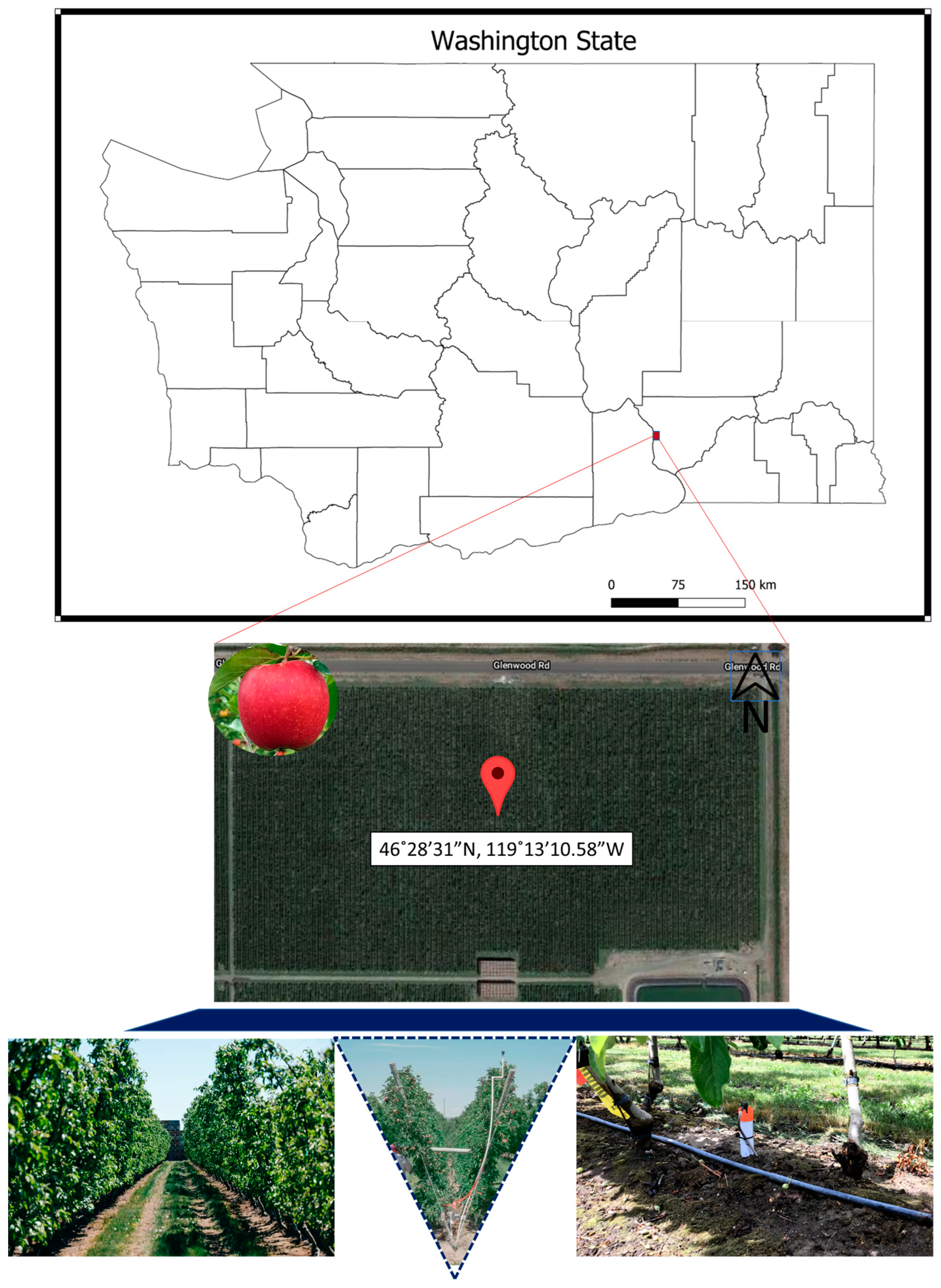

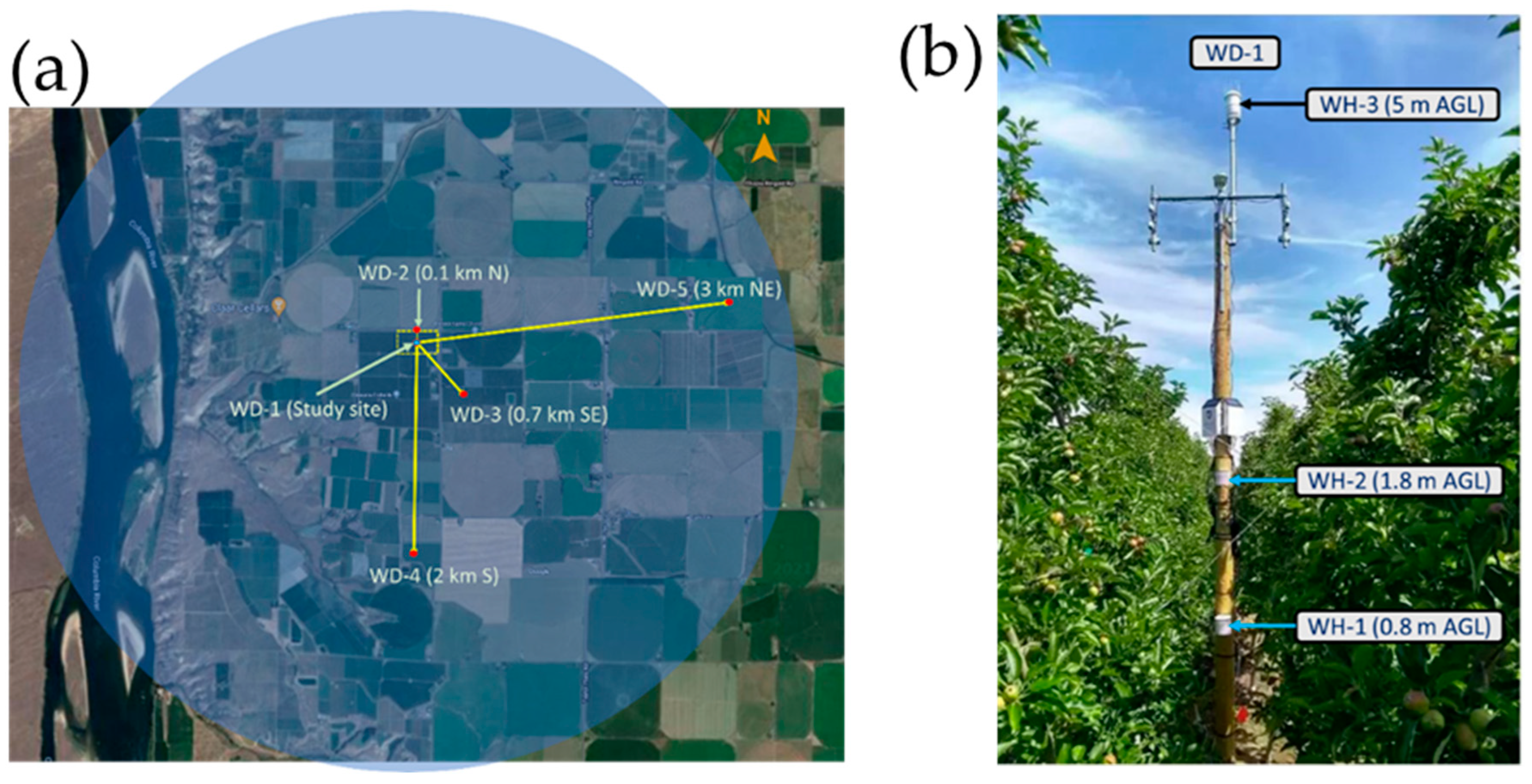
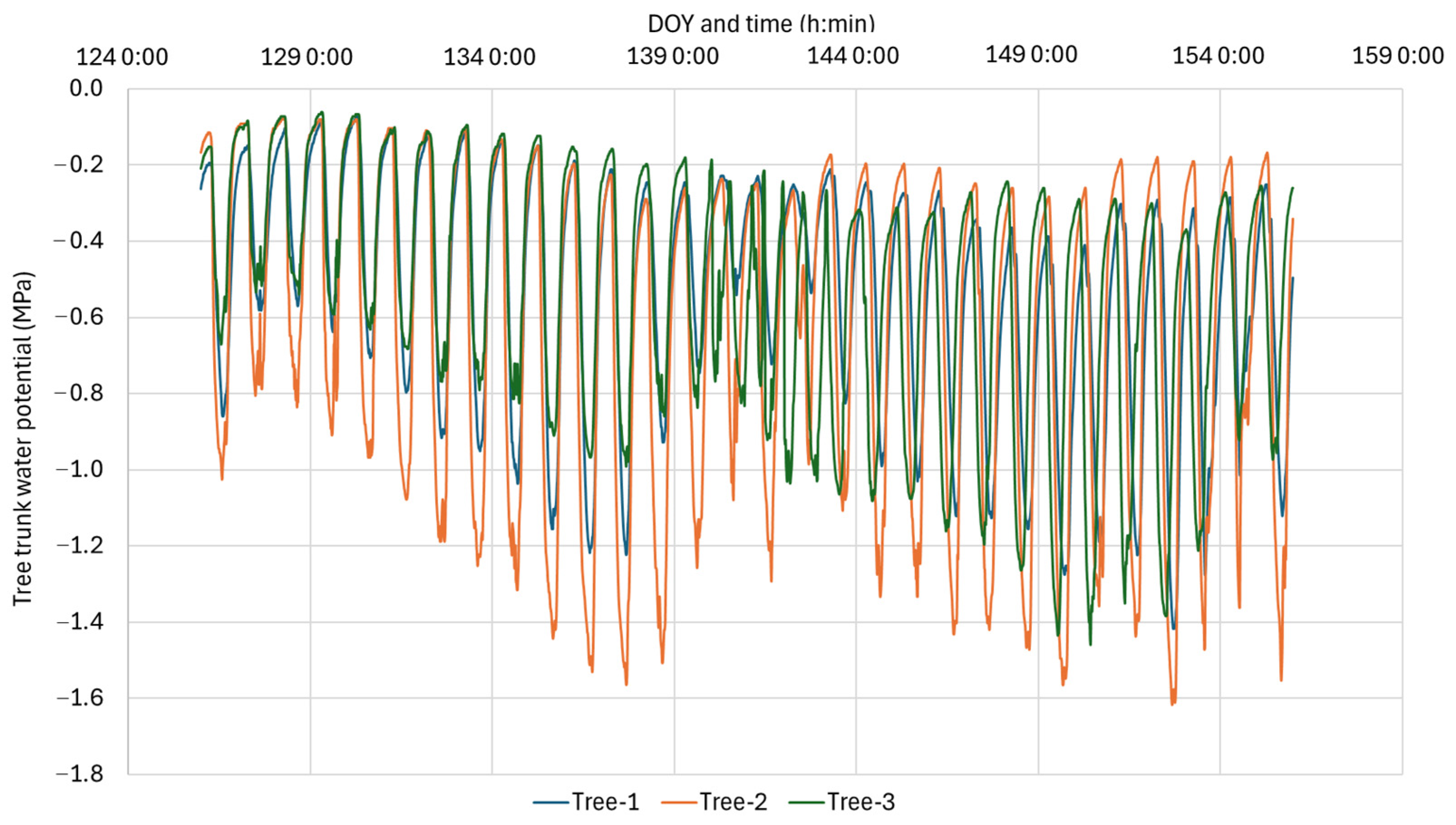
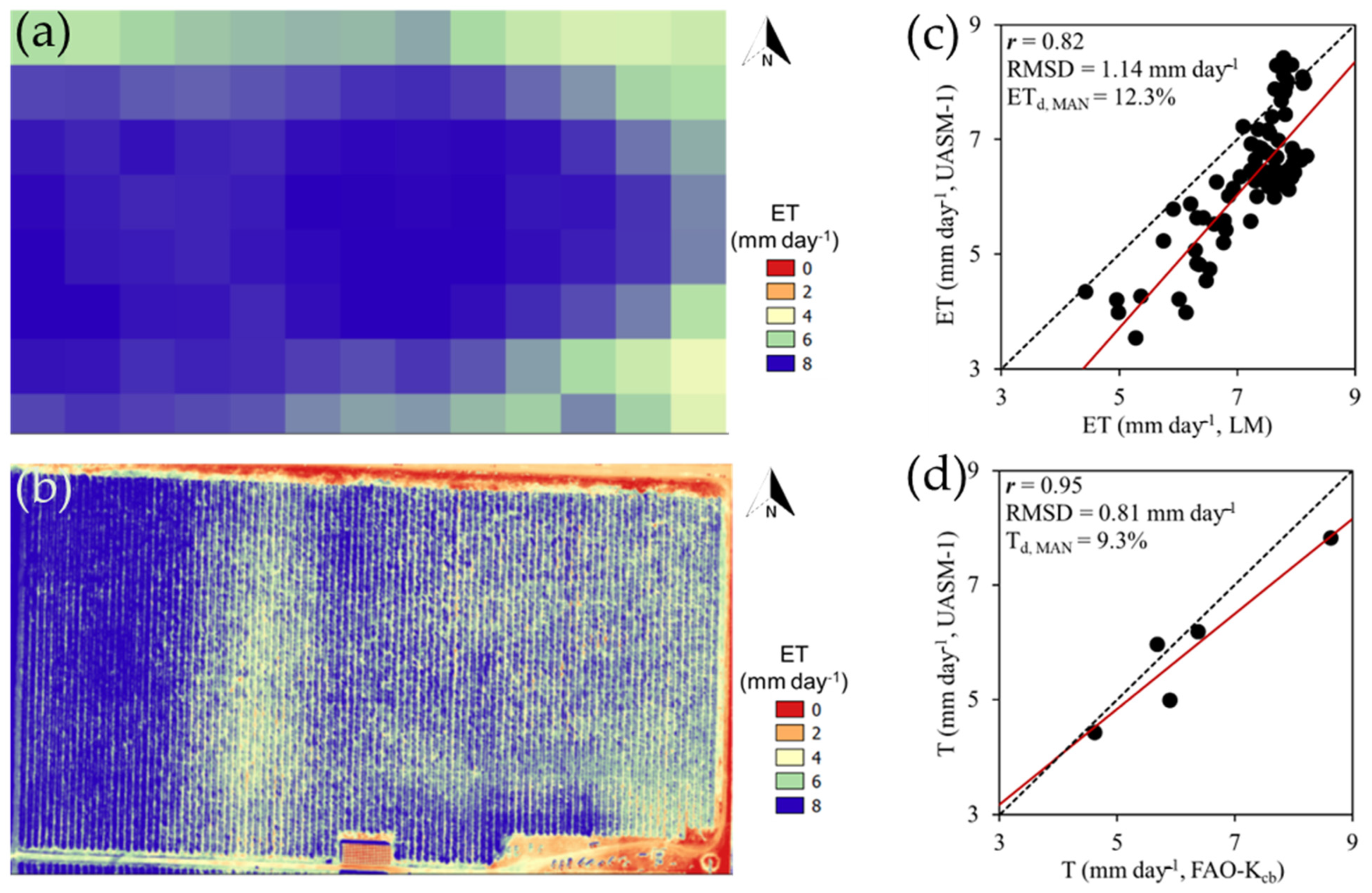


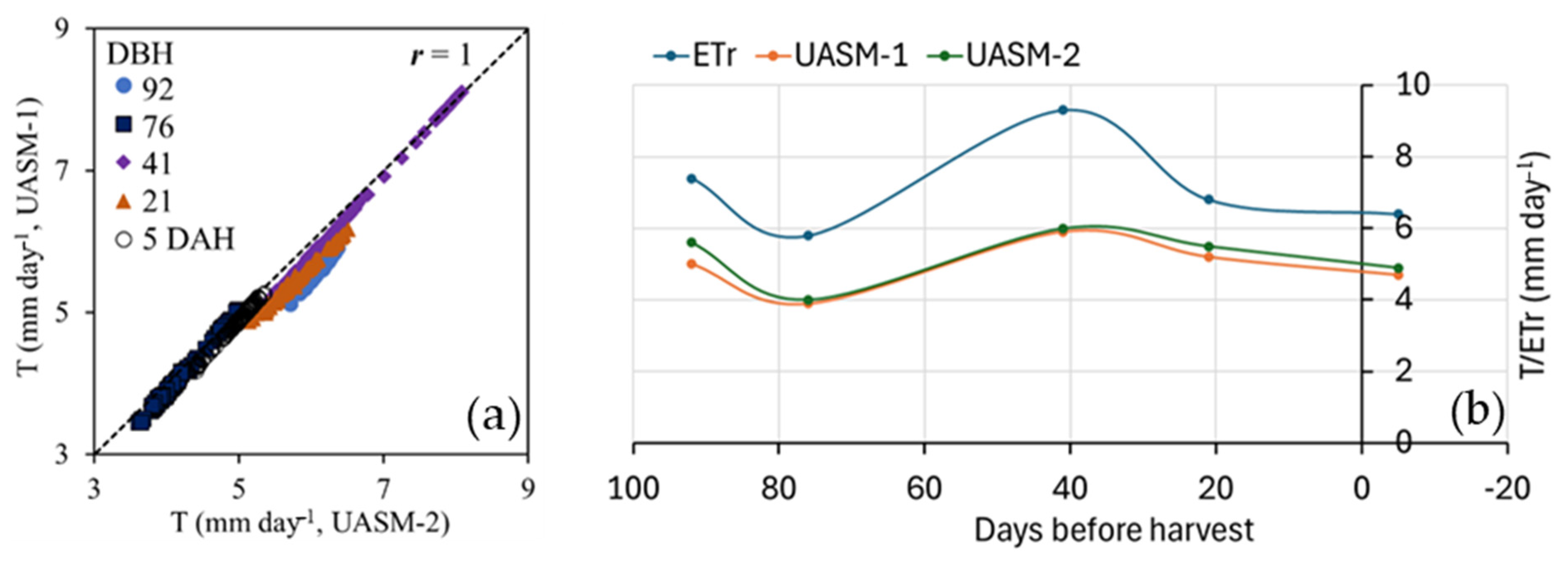

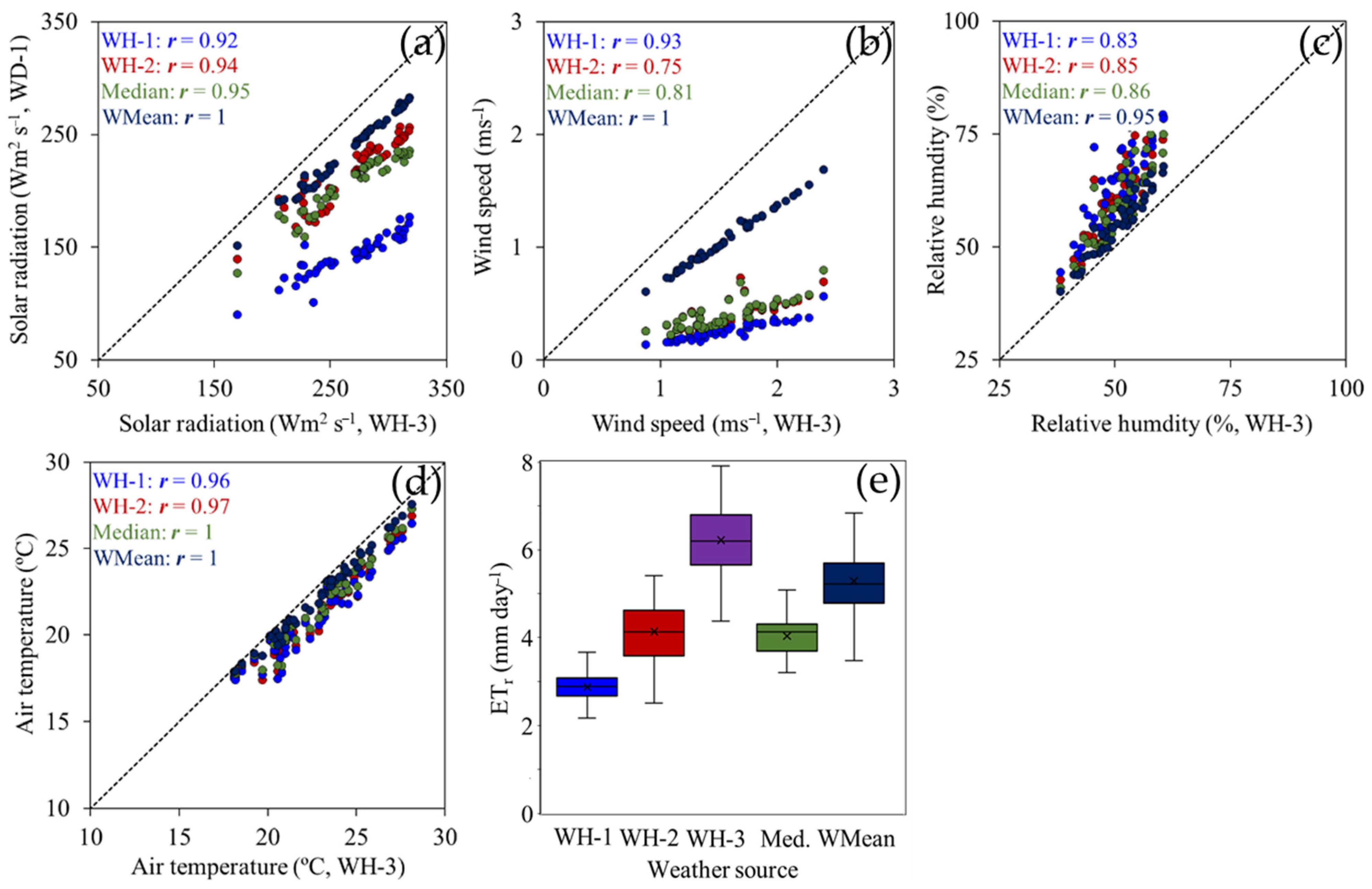
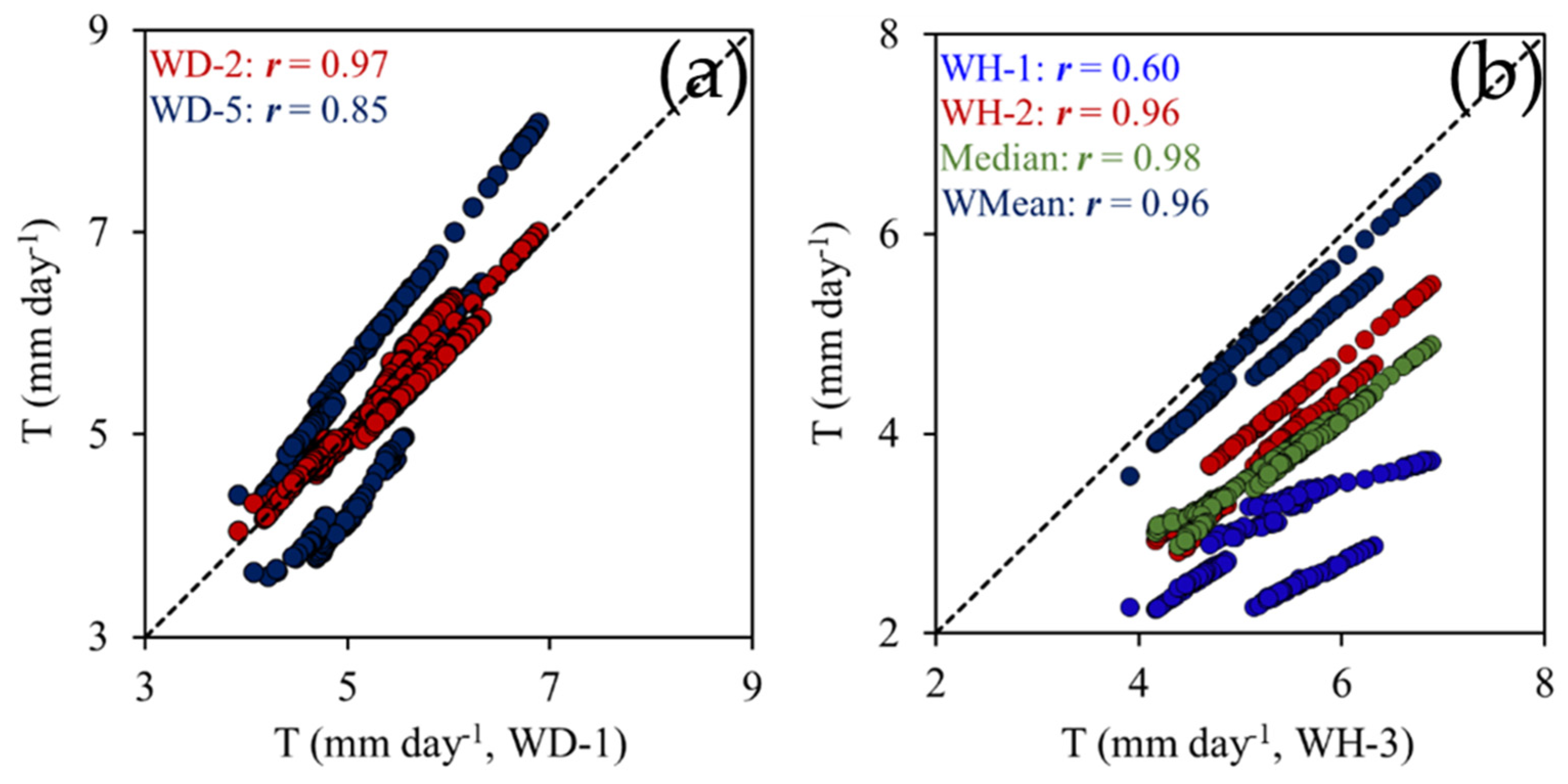
| Source | Latitude (°N) | Longitude (°W) | Ground Elevation (m, a AMSL) | Sensor Height (m, b AGL) |
|---|---|---|---|---|
| WD-1 | 46.475 | 119.219 | 277 | 5.0 |
| WD-2 | 46.476 | 119.220 | 277 | 1.8 |
| WD-3 | 46.471 | 119.211 | 283 | 2.0 |
| WD-4 | 46.440 | 119.220 | 270 | 2.0 |
| WD-5 | 46.483 | 119.184 | 267 | 2.0 |
| WH-1 | 46.475 | 119.219 | 277 | 0.8 |
| WH-2 | 46.475 | 119.219 | 277 | 1.8 |
| WH-3 | 46.475 | 119.219 | 277 | 5.0 |
| Median | 46.475 | 119.219 | 277 | 1.8 |
| WMean | 46.475 | 119.219 | 277 | 2.5 |
| Approach | a LAI | b ISWR | c OLWR | d ILWR | e Rn | f G | g Zom | h H | i ET | |
|---|---|---|---|---|---|---|---|---|---|---|
| DBH: 92 (j ETr = 7.4) | UASM-1 | 1.7 (1.5) | 850 | 445 (56) | 350 (46) | 658 (46) | 52 (36) | 0.6 (0.3) | 238 (82) | 5.0 (2.0) |
| UASM-2 | 2.3 (1.2) | 831 | 448 (55) | 341 | 630 (81) | 47 (27) | 0.6 (0.3) | 170 (35) | 5.6 (1.6) | |
| DBH: 76 (ETr = 5.8) | UASM-1 | 1.6 (1.4) | 706 | 461 (48) | 366 (40) | 535 (33) | 42 (27) | 0.7 (0.3) | 244 (38) | 3.9 (1.2) |
| UASM-2 | 2.2 (1.1) | 563 | 464 (48) | 358 | 497 (61) | 29 (13) | 0.6 (0.3) | 110 (13) | 4.0 (1.0) | |
| DBH: 41 (ETr = 9.3) | UASM-1 | 1.8 (1.0) | 892 | 499 (47) | 391 (39) | 678 (38) | 69 (35) | 0.7 (0.3) | 225 (74) | 5.9 (2.0) |
| UASM-2 | 2.4 (0.9) | 829 | 503 (48) | 365 | 594 (69) | 58 (23) | 0.6 (0.2) | 193 (39) | 6.0 (1.8) | |
| DBH: 21 (ETr = 6.8) | UASM-1 | 2.6 (1.4) | 870 | 486 (48) | 379 (40) | 652 (38) | 54 (35) | 0.6 (0.3) | 199 (42) | 5.2 (1.3) |
| UASM-2 | 2.9 (1.1) | 795 | 488 (47) | 368 | 575 (69) | 46 (22) | 0.5 (0.2) | 104 (18) | 5.5 (1.3) | |
| DAH: 5 (ETr = 6.4) | UASM-1 | 1.7 (1.1) | 791 | 426 (38) | 335 (32) | 608 (28) | 40 (24) | 0.7 (0.3) | 233 (42) | 4.7 (1.1) |
| UASM-2 | 2.4 (1.0) | 725 | 429 (38) | 340 | 553 (52) | 35 (18) | 0.6 (0.3) | 174 (22) | 4.9 (1.0) |
Disclaimer/Publisher’s Note: The statements, opinions and data contained in all publications are solely those of the individual author(s) and contributor(s) and not of MDPI and/or the editor(s). MDPI and/or the editor(s) disclaim responsibility for any injury to people or property resulting from any ideas, methods, instructions or products referred to in the content. |
© 2025 by the authors. Licensee MDPI, Basel, Switzerland. This article is an open access article distributed under the terms and conditions of the Creative Commons Attribution (CC BY) license (https://creativecommons.org/licenses/by/4.0/).
Share and Cite
Chandel, A.K.; Khot, L.R.; Stöckle, C.O.; Kalcsits, L.; Mantle, S.; Rathnayake, A.P.; Peters, T.R. Canopy Transpiration Mapping in an Apple Orchard Using High-Resolution Airborne Spectral and Thermal Imagery with Weather Data. AgriEngineering 2025, 7, 154. https://doi.org/10.3390/agriengineering7050154
Chandel AK, Khot LR, Stöckle CO, Kalcsits L, Mantle S, Rathnayake AP, Peters TR. Canopy Transpiration Mapping in an Apple Orchard Using High-Resolution Airborne Spectral and Thermal Imagery with Weather Data. AgriEngineering. 2025; 7(5):154. https://doi.org/10.3390/agriengineering7050154
Chicago/Turabian StyleChandel, Abhilash K., Lav R. Khot, Claudio O. Stöckle, Lee Kalcsits, Steve Mantle, Anura P. Rathnayake, and Troy R. Peters. 2025. "Canopy Transpiration Mapping in an Apple Orchard Using High-Resolution Airborne Spectral and Thermal Imagery with Weather Data" AgriEngineering 7, no. 5: 154. https://doi.org/10.3390/agriengineering7050154
APA StyleChandel, A. K., Khot, L. R., Stöckle, C. O., Kalcsits, L., Mantle, S., Rathnayake, A. P., & Peters, T. R. (2025). Canopy Transpiration Mapping in an Apple Orchard Using High-Resolution Airborne Spectral and Thermal Imagery with Weather Data. AgriEngineering, 7(5), 154. https://doi.org/10.3390/agriengineering7050154










